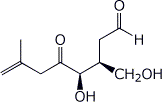Organic Chemistry II |
 |
|
Professor Carl C. Wamser |
||
Chem 335 - Winter 2009 |
Final Exam |
![]()
Organic Chemistry II |
 |
|
Professor Carl C. Wamser |
||
Chem 335 - Winter 2009 |
Final Exam |
![]()
1. (25 points) Write complete names for each of the following, including stereochemistry if it is specifically shown.
a) 
b) ![]()
c) 
d) 
e) 
2. (18 points) Write accurate structures for the following:
a) the HOMO of allyl radical
b) p-methoxybenzyl cation
c) dimethyl sulfoxide (DMSO)
d) dichlorocarbene (show all valence electrons)
e) the hemiacetal from formaldehyde and methanol
f) the aldol product from acetone (not dehydrated)
3. (15 points) Arrange the following in order with respect to the property indicated. Write MOST and LEAST under the compounds with the highest and lowest values, respectively.
a) acidity

b) reactivity towards bromine
![]()
c) reactivity towards a typical nucleophile
![]()
d) number of absorptions in its C-13 NMR spectrum

e) relative proportion of para product
![]()
4. (24 points) Write all the resonance forms for the intermediates that would be formed below (not the full reaction, just the initially formed intermediate).
a) 
b) 
c) 
d) 
5. (15 points) Complete each of the following reactions by adding the missing part: either the starting compound, the necessary reagents and conditions, or the final major product. Show stereochemistry if it is specific.
a) 
b) 
c) 
d) ![]()
e) 
6. (15 points) Complete each of the following reactions by adding the missing part: either the starting compound, the necessary reagents and conditions, or the final major product. Show stereochemistry if it is specific.
a) 
b) ![]()
c) 
d) 
e) 
7. (13 points) Show how to synthesize the compound shown below, starting with benzene and ethanol as the only sources of carbon in the final product.

8. (15 points) Write a complete acid-catalyzed mechanism for the formation of the dimethyl acetal of cyclopentanone. Show all steps and show all resonance forms for any intermediates.

9. (15 points) Write a complete mechanism for the base-catalyzed condensation shown below. Show all steps and show all resonance forms for any intermediates.

10. (15 points) An enol ether (shown below) undergoes acid-catalyzed hydrolysis to a ketone plus an alcohol. Write a complete acid-catalyzed mechanism. Show all steps and show all resonance forms for any intermediates. (HINT - a hemiacetal is an intermediate.)

11. (15 points) Identify the unknown compound based on the data provided.
Molecular formula is C10 H14
Calculate IHD =
Indicate where the parent molecular ion would appear - m/z =
C-13 NMR shows just four peaks at 10, 20, 120, and 140 ppm
H-1 NMR shows just three peaks at 1.0 ppm (triplet), 2.5 ppm (quartet), 7.0 ppm (singlet)
12. (15 points) Identify the unknown compound based on the data provided.
Molecular formula is C4 H7 Br O3
Calculate IHD =
IR spectrum shows strong, broad peaks at 1700 and 3100 cm-1
H-1 NMR spectrum:
3.2 ppm, 2H, triplet
3.5 ppm, 2H, triplet
3.7 ppm, 2H, singlet
12 ppm, 1H, singlet